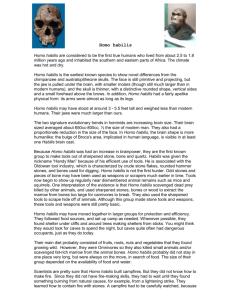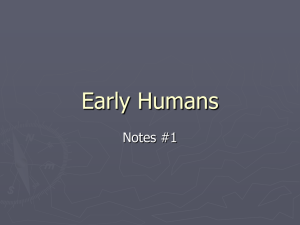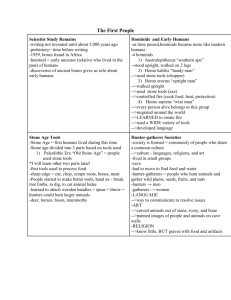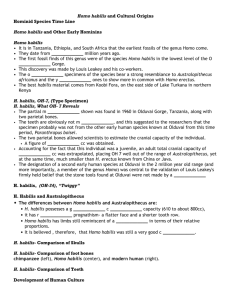Homo Habilis: Early Humans, Tools, and the Stone Age
advertisement
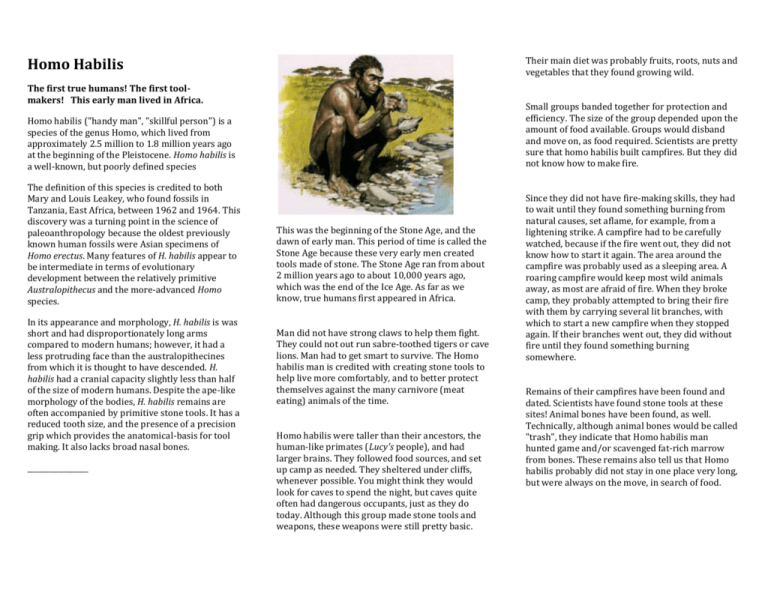
Homo Habilis Their main diet was probably fruits, roots, nuts and vegetables that they found growing wild. The first true humans! The first toolmakers! This early man lived in Africa. Small groups banded together for protection and efficiency. The size of the group depended upon the amount of food available. Groups would disband and move on, as food required. Scientists are pretty sure that homo habilis built campfires. But they did not know how to make fire. Homo habilis ("handy man", "skillful person") is a species of the genus Homo, which lived from approximately 2.5 million to 1.8 million years ago at the beginning of the Pleistocene. Homo habilis is a well-known, but poorly defined species The definition of this species is credited to both Mary and Louis Leakey, who found fossils in Tanzania, East Africa, between 1962 and 1964. This discovery was a turning point in the science of paleoanthropology because the oldest previously known human fossils were Asian specimens of Homo erectus. Many features of H. habilis appear to be intermediate in terms of evolutionary development between the relatively primitive Australopithecus and the more-advanced Homo species. In its appearance and morphology, H. habilis is was short and had disproportionately long arms compared to modern humans; however, it had a less protruding face than the australopithecines from which it is thought to have descended. H. habilis had a cranial capacity slightly less than half of the size of modern humans. Despite the ape-like morphology of the bodies, H. habilis remains are often accompanied by primitive stone tools. It has a reduced tooth size, and the presence of a precision grip which provides the anatomical-basis for tool making. It also lacks broad nasal bones. _________________ This was the beginning of the Stone Age, and the dawn of early man. This period of time is called the Stone Age because these very early men created tools made of stone. The Stone Age ran from about 2 million years ago to about 10,000 years ago, which was the end of the Ice Age. As far as we know, true humans first appeared in Africa. Man did not have strong claws to help them fight. They could not out run sabre-toothed tigers or cave lions. Man had to get smart to survive. The Homo habilis man is credited with creating stone tools to help live more comfortably, and to better protect themselves against the many carnivore (meat eating) animals of the time. Homo habilis were taller than their ancestors, the human-like primates (Lucy's people), and had larger brains. They followed food sources, and set up camp as needed. They sheltered under cliffs, whenever possible. You might think they would look for caves to spend the night, but caves quite often had dangerous occupants, just as they do today. Although this group made stone tools and weapons, these weapons were still pretty basic. Since they did not have fire-making skills, they had to wait until they found something burning from natural causes, set aflame, for example, from a lightening strike. A campfire had to be carefully watched, because if the fire went out, they did not know how to start it again. The area around the campfire was probably used as a sleeping area. A roaring campfire would keep most wild animals away, as most are afraid of fire. When they broke camp, they probably attempted to bring their fire with them by carrying several lit branches, with which to start a new campfire when they stopped again. If their branches went out, they did without fire until they found something burning somewhere. Remains of their campfires have been found and dated. Scientists have found stone tools at these sites! Animal bones have been found, as well. Technically, although animal bones would be called "trash", they indicate that Homo habilis man hunted game and/or scavenged fat-rich marrow from bones. These remains also tell us that Homo habilis probably did not stay in one place very long, but were always on the move, in search of food.




